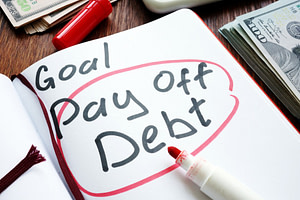
It’s a great time for us to talk about DEBT… considering the economic environment we are in and the old spending habits many people have.
Besides, if you don’t understand Debt, it’s unlikely you’ll ever become rich….
Many people settle to seeing debt as “normal”, as a common aspect of our modern life.
And I want to invite you to pause and think about it…
How is it “normal” to owe more than you have?
For certain valuable or income producing investments like a house, your education, profitable rental properties….it does make sense to borrow money.
And sometimes you have to dip into credit card debt because you cope with temporary gap in income or unexpected medical emergency….
Life sends us a curveball from time to time and we handle it the best we can, right?
But what about some random, impulsive purchases on credit cards?
What about buying things on credit cards that depreciate the minute you bring these things home yet you’ll have to pay for them for several months or years (e.g. a new car)?
Many people got addicted to the Bad debt. It’s easy to give a piece of plastic and get the goodies you want at this moment.
Some people think about how they’re going to pay for the purchase, other’s kick the can down the road, thinking they’ll figure it out somehow later on.
Well, today is the day to learn how you can systematize paying off your credit card debt.
Credit card interest is called APR, which stands for the Annual Percentage Rate (APR).
Most cards don’t charge APR, if you pay your balance in full each month by the due date.
That’s the best way to use credit cards.
Debt has historically been a negative term. However, the rich folks use debt to become even richer.
So, Debt is a powerful tool that needs to be understood and handled carefully, because it can help you accumulate financial wealth or wipe it out.
Different Kinds of Debt
There’re 2 kinds of Debt – “good Debt” and “bad Debt.”
1. BAD DEBT
Having high-interest consumer debt can be very dangerous and extremely stressful.
Yet, it is widespread and often even encouraged in our societies by credit card companies and banks.
Here are some examples of BAD DEBT:
- Banks agree to give you loans despite your poor credit rating and charge you “higher-than-current-market” interest rate to compensate for their risk
- Credit card companies allow (encourage!) you to carry over balances paying them high-interest on these balances
- Colleges make arrangements for you to obtain student loans that will cover your “out-of-control tuition cost” even though most jobs after college don’t pay enough to pay off the college loans.
The bottom line: BAD DEBT = HIGH RISK.
Lenders don’t do it “for you” but rather “to you.”
They don’t land you money because you are an honest and deserving person. It’s strictly business and a profitable one.
However, Not ALL Debt is bad debt!
2. GOOD DEBT
Good debt is referred to as Financial Leverage.
Leverage means borrowing money to invest in appreciating and/or income-producing assets in order to grow wealth.
It is one of the levers rich people use to create and grow wealth.
So, when you use financial leverage to CREATE wealth, you incur GOOD DEBT.
Here are some examples of GOOD DEBT:
- Buying a house in a economically growing area, that you can afford
- Buying profitable rental properties that generate positive cash flow for you
- Investing in your growing business or buying a profitable business
- Obtaining a reasonable student loan for a profession that requires formal educational credentials
- Investing in YOU – your health and your education – because YOU ARE your most valuable and appreciating asset!)
GOOD DEBT = WEALTH
However, in many life situations, debt is unnecessary and often dangerous.
It is unnecessary because there are often more gradual and less expensive ways to get what you want.
It is dangerous because it often becomes a downward spiral that ruins your health, your relationships and your overall wellbeing.
So, what is the ‘responsible way’ to use financial leverage when you buy ‘stuff’?
Here’s my take on this:
When you borrow money to buy an asset (e.g. a car, a house, a rental property, a business, or stocks), make sure to ask yourself the following 3 questions:
1. Can I afford to pay it back?
2. Is a potential return on the borrowed money higher than the cost of borrowing it, so the debt will pay for itself?
3. What will happen if I am wrong and will not be able to pay the debt service?
Remember the old Warren Buffett’s quote: “Never risk what you have and need, for what you don’t have and don’t need.”
Two Ways to Repay Consumer Debt
There’re 2 schools of thought as it comes to paying off credit card debt:
1. Standard method (aka highest cost method)
2. Snowball method (coined by Dave Ramsey)
1. STANDARD METHOD (aka Highest Cost)
In this method, you pay the minimum require payment on all your cards but pay more on the card with the highest interest.
Once you pay of the card with the highest interest, you do the same with the next highest interest card, while paying a minimum payment on the rest of the card.
It’s a mathematical approach to paying of debt where you’re paying off the card that costs you the most.
2. SNOWBALL METHOD (coined by Dave Ramsey)
In this method, you’re paying the minimum on all credit cards as well, but you’re paying more to the card with the minimum balance.
Once you pay off the first credit card, you repeat the same process with the next minimum-balance credit card.
This method is all about human psychology and getting small wins. Because once you pay off the first credit card, you get more motivated to pay of the rest.
Which Debt repayment method will you choose?
Which one “lands” better on you?
Technically, the “snowball method” is not the most cost-efficient approach because the card with the lowest balance does not necessarily have the highest interest (aka APR).
However, psychologically, it’s very rewarding to see your first credit card paid off, and it motivates you to pay off other cards more quickly.
Either method works when you work it.
So, choose which method you want to use and get started…TODAY.
Millen Livis, M.S., M.B.A.
P.S. You’ll receive the Part 2 of this newsletter next week.
P.P.S. If you want to watch my 3-part mini-training on this topic, you can find the recording of this entire training on my youtube channel – Millen Livis Channel Wealth.

